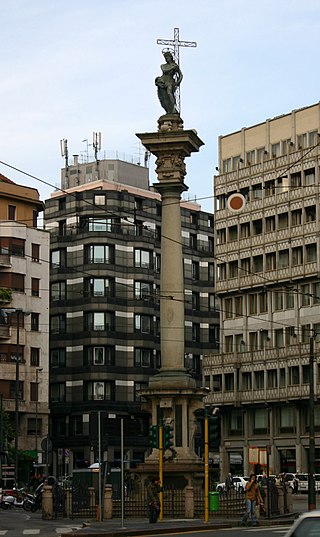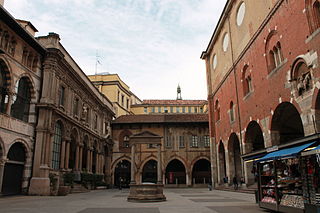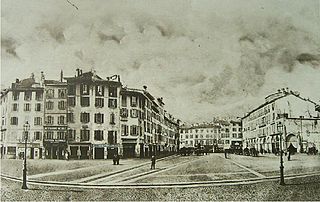
The Galleria Vittorio Emanuele II is Italy's oldest active shopping gallery and a major landmark of Milan. Housed within a four-story double arcade in the centre of town, the Galleria is named after Victor Emmanuel II, the first king of the Kingdom of Italy. It was designed in 1861 and built by architect Giuseppe Mengoni between 1865 and 1877.

Piazza del Duomo is the main piazza of Milan, Italy. It is named after, and dominated by, Milan Cathedral. The piazza marks the center of the city, both in a geographic sense and because of its importance from an artistic, cultural, and social point of view. Rectangular in shape, with an overall area of 17,000 m2, the piazza includes some of the most important buildings of Milan, as well some of the most prestigious commercial activities, and it is by far the foremost tourist attraction of the city.

The Palazzo della Ragione is a medieval market hall, town hall and palace of justice building in Padua, in the Veneto region of Italy. The upper floor was dedicated to the town and justice administration; while the ground floor still hosts the historical covered market of the city. The palace separates the two market squares of Piazza delle Erbe from Piazza dei Frutti. It is popularly called "il Salone" . It is part of the UNESCO World Heritage Site of Padua's 14th-century fresco cycles.

Piazza della Repubblica is a city square in Florence, Italy. It was originally the site of the city's forum; then of its old ghetto, which was swept away during the improvement works, or Risanamento, initiated during the brief period when Florence was the capital of a reunited Italy—work that also created the city's avenues and boulevards. At that time, the Loggia del Pesce from the Mercato Vecchio was also moved to Piazza Ciompi. The square's Giubbe Rosse cafe has long been a meeting place for famous artists and writers, notably those of Futurism.

The Loggia degli Osii is a Gothic-style civic building of Milan, Italy. It is located in Piazza Mercanti, a central city square of Milan that used to be its centre in the Middle Ages.

Corso Buenos Aires is a major street in north-eastern Milan, Italy. With over 350 shops and outlets, it features the highest concentration of clothing stores in Europe. The architecture of the area is mostly late 19th- and 20th-century style; the street and its surroundings are pointed with several neo-classical and Art Nouveau buildings.

Villas and palaces in Milan are used to indicate public and private buildings in Milan of particular artistic and architectural value. The lack of a royal court did not give Milan the prerequisites for a significant development of building construction; nevertheless it contains architectural works from different eras and different styles: from Romanesque to neo-Gothic, from Baroque to eclectic, from Italian twentieth century to rationalism.

The Royal Palace of Milan was the seat of government in the Italian city of Milan for many centuries. Today, it serves as a cultural centre and it is home to international art exhibitions. It spans through an area of 7,000 square meters and it regularly hosts modern and contemporary art works and famous collections in cooperation with notable museums and cultural institutions from across the world. More than 1,500 masterpieces are on display annually.

Piazza Cordusio is a square in central Milan, Italy. The piazza takes its name from the Cors Ducis which was located on the square during Longobard times. It is well known for its several turn-of-the-19th-century Neoclassical, eclectic and Art Nouveau buildings, banks and post offices. Even though many of these have now relocated elsewhere, it is still an important commercial square in the city and hosts the Palazzo delle Assicurazioni Generali, the Palazzo del Credito Italiano and the Palazzo delle Poste, former Borsa di Milano. Piazzale Cordusio hosts the Cordusio metro station and is the starting point of the elegant pedestrian Via Dante which leads to the imposing medieval Castello Sforzesco, or Milan Castle. Opposite to Via Dante, Cordusio borders onto Piazza Mercanti, former city centre in the Middle Ages, which leads directly to Piazza del Duomo, today's city centre.

Novara Cathedral is a Roman Catholic cathedral, dedicated to the Assumption of the Virgin Mary, located at the Piazza della Repubblica in Novara, Piedmont, Italy. It is the seat of the Bishop of Novara.
The city of Milan, Italy, has had three different systems of defending walls. The oldest, the Roman walls, were developed in two stages: the first in the Republican era and the second in the Imperial era. The second wall system was realized in the Middle Ages, after the destruction of the city by Frederick I Barbarossa. Finally, the latest wall system was built by the Spanish rulers in the 16th century. While very little remains of these walls, their structure is clearly reflected in the urbanistic layout of the city. In particular, modern Milan has two roughly circular rings of streets, namely the "Cerchia dei Navigli" and the "Cerchia dei Bastioni", which essentially correspond to the Medieval and Spanish walls, respectively. Note that a third ring of roads just beyond the Inner Ring Road, called the External Ring Road, does not follow any old city walls, but rather was part of the 1884 Beruto Plan for the city of Milan, created and named after a municipal engineer and public servant to the local city government.

The Verziere was the traditional greengrocery street market of Milan, Italy. The market itself has been relocated several times, and it is now in Via Lombroso, east of the city centre; the word "Verziere", anyway, still refers to the main historic location of the market, where it was held from 1776 century until 1911. The new greengrocery market of Via Lombroso is more properly referred to as "Ortomercato" or "Mercati Generali".

Palazzo Marino is a 16th-century palace located in Piazza della Scala, in the centre of Milan, Italy. It has been Milan's city hall since 9 September 1861. It borders on Piazza San Fedele, Piazza della Scala, Via Case Rotte and Via Tommaso Marino.

Piazza Mercanti is a central city square of Milan, Italy. It is located between Piazza del Duomo, which marks the centre of the modern city of Milan, and Piazza Cordusio, and it used to be the heart of the city in the Middle Ages. At the time, the square was larger than it is now and known as "Piazza del Broletto", after the "Broletto Nuovo", the palace that occupied the centre of the square. In the 13th century, there were six entry points to the square, each associated to a specific trade, from sword blacksmiths to hat makers.

The Giureconsulti Palace, also known as Palazzo Affari ai Giureconsulti or simply Palazzo Affari, is a 16th-century building of Milan, Italy. It is located in Piazza Mercanti, former city centre in the Middle Ages.

Piazza della Scala is a pedestrian central square of Milan, Italy, connected to the main square of Milan, Piazza del Duomo, by the Galleria Vittorio Emanuele II passage. It is named after the renowned Teatro alla Scala opera house, which occupies the north-western side of the square; the building actually includes both the opera house and the Museo Teatrale alla Scala, dedicated to the history of La Scala and opera in general. On the opposite side to "La Scala", to the south-east, is the facade of Palazzo Marino, Milan's city hall. Another relevant building on the square, on the north-eastern side, is the Palazzo della Banca Commerciale Italiana. The south-western side of the square has the entry to the Galleria Vittorio Emanuele as well as Palazzo Beltrami. Most of the architecture of the square is due to architect Luca Beltrami, who designed the eponymous palace, the facade of Palazzo Marino, and the Banca Commerciale Italiana building. The centre of the square is marked by the monument of Leonardo da Vinci by sculptor Pietro Magni (1872).

The Zone 1 of Milan, since 2016 officially Municipality 1 of Milan, is one of the 9 administrative divisions of Milan, Italy.

The Rebecchino was a historic neighborhood of Milan, Italy, located in the immediate surroundings of Milan's Cathedral, in what is now Piazza del Duomo. The neighborhood was demolished in the second half of the 19th century to allow for the thorough redesign of the piazza that led to its modern, monumental layout.

Piazza Dante is the main public square in Grosseto, Tuscany, Italy.

Piazza del Liberty is a pedestrian square located along Via San Paolo, one block north of the Corso Vittorio Emanuele II, some 3 blocks north east of the Duomo in central Milan, region of Lombardy, Italy. The piazza was created in part in the space after the destruction of the Teatro Milanese during the Allied bombardment in 1943, and takes its name from the Art Nouveau facade decoration of one of its buildings. It is now complemented by chic shops and modern fountains.


















